Written by: Chainalysis
Translated by: Chopper, Foresight News
We are pleased to share the 2025 Chainalysis Global Cryptocurrency Adoption Index. In each annual report, we examine on-chain and off-chain data to determine which countries are leading the world in grassroots cryptocurrency adoption. Our research highlights the countries where unique cryptocurrency use cases are taking root and explores why people around the world are embracing cryptocurrency.
Top 20 Global Cryptocurrency Adoption Index for 2025
In 2025, the Asia-Pacific region further solidified its position as the global center for grassroots cryptocurrency activity, led by India, Pakistan, and Vietnam, where the population drives widespread adoption of both centralized and decentralized services. Meanwhile, North America climbed to second place in regional rankings due to regulatory momentum, including the approval of spot Bitcoin ETFs and clearer institutional frameworks, which help legitimize participation in cryptocurrency within traditional financial channels and accelerate its development.

Asia-Pacific is the Fastest Growing Region
In the 12 months ending June 2025, the Asia-Pacific region became the fastest-growing area for on-chain cryptocurrency activity, with value received increasing by 69% year-on-year. The total cryptocurrency trading volume in the Asia-Pacific region grew from $1.4 trillion to $2.36 trillion, driven by strong participation from major markets like India, Vietnam, and Pakistan.
Following closely is Latin America, where cryptocurrency adoption grew by 63%, reflecting rising adoption rates among both retail and institutional levels. In contrast, the adoption rate in Sub-Saharan Africa grew by 52%, indicating that the region continues to rely on cryptocurrency for remittances and everyday payments. These figures highlight a broad shift in the momentum of cryptocurrency development towards the Global South, where practical applications increasingly drive cryptocurrency adoption.
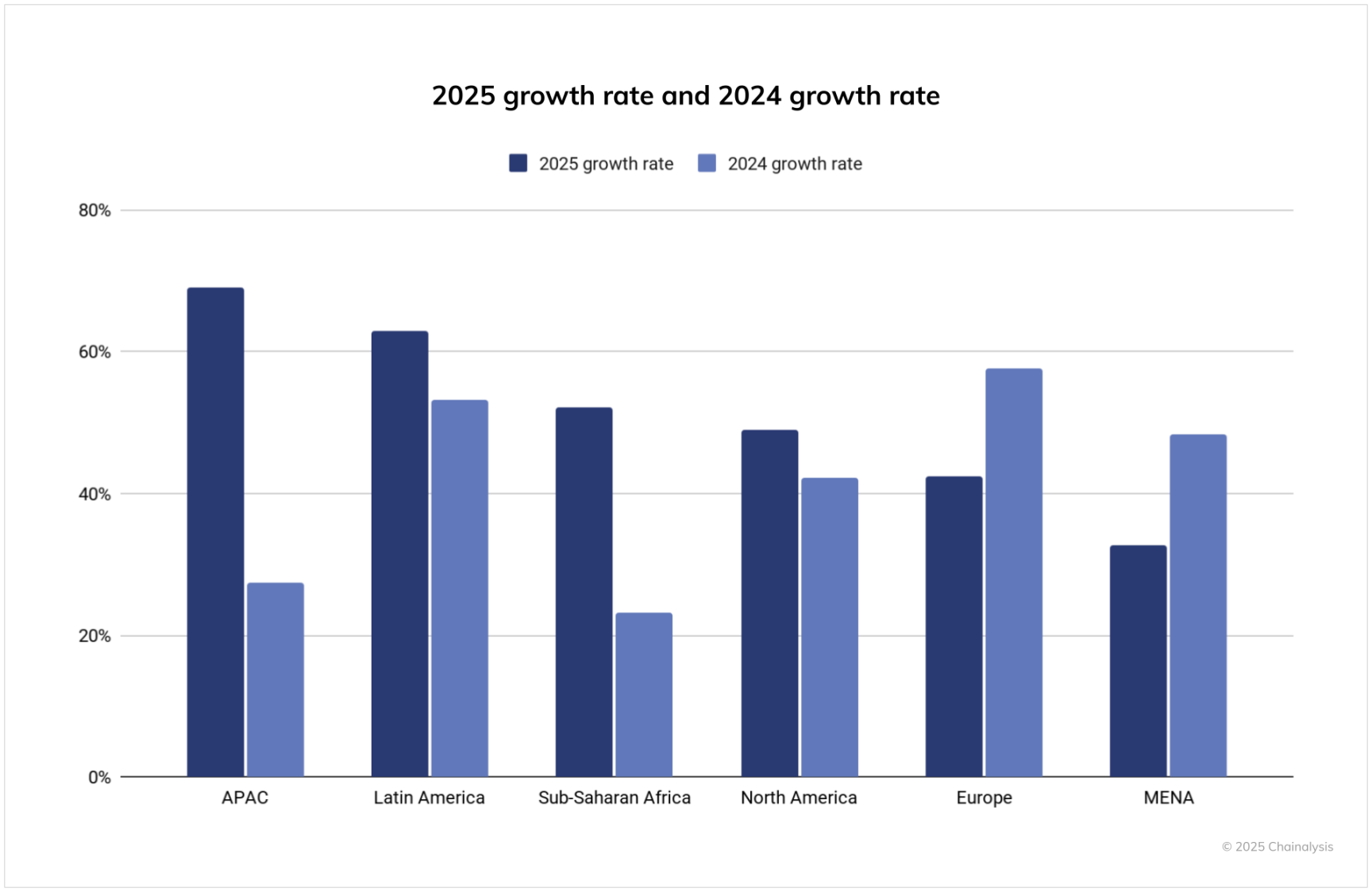
Meanwhile, in absolute terms, North America and Europe still dominate, receiving over $2.2 trillion and $2.6 trillion, respectively, in the past year. The 49% growth in North America reflects a year of renewed institutional interest in cryptocurrency, aided by the launch of spot Bitcoin ETFs and increased regulatory clarity. The 42% growth in Europe, while lower than other regions, still represents significant growth given its already high baseline, highlighting the continent's ongoing institutional activity and expanding user base. Meanwhile, the growth in the Middle East and North Africa was more moderate at 33%, indicating a slower adoption rate compared to other emerging markets, although total trading volume still exceeded $500 billion.
Almost every region experienced accelerated growth compared to the previous year, particularly notable in the Asia-Pacific and Latin America. Last year, the growth rate in the Asia-Pacific was only 27%, but in the recent period, this number more than doubled to 69%. Similarly, Latin America's year-on-year growth rate jumped from 53% to 63%, solidifying the region's position as one of the fastest-growing centers for cryptocurrency. Rapid growth was also observed in Europe, the Middle East and North Africa, and Sub-Saharan Africa, indicating widespread expansion globally. Interestingly, North America's growth rate also increased from 42% to 49%, further indicating that the regulatory clarity and institutional capital inflows of 2025 are beginning to show in trading-level data.
A New Picture Adjusted for Population: Eastern Europe Dominates
Our index traditionally focuses on activity adjusted for GDP per capita, which works best when cryptocurrency is niche and concentrated among high-volume users. However, as the scope of adoption broadens, population-adjusted metrics can more clearly show where cryptocurrency is gaining real grassroots traction.
When we adjust our index for population, we find a very different set of leading countries. Eastern European countries, including Ukraine, Moldova, and Georgia, rank at the top, reflecting high levels of cryptocurrency activity relative to their population size. Economic uncertainty, distrust of traditional financial institutions, and strong technological literacy in the region may have driven the adoption of cryptocurrency in Eastern Europe. These factors make cryptocurrency an attractive alternative for wealth preservation and cross-border transactions, especially in countries facing inflation, war, or banking restrictions.
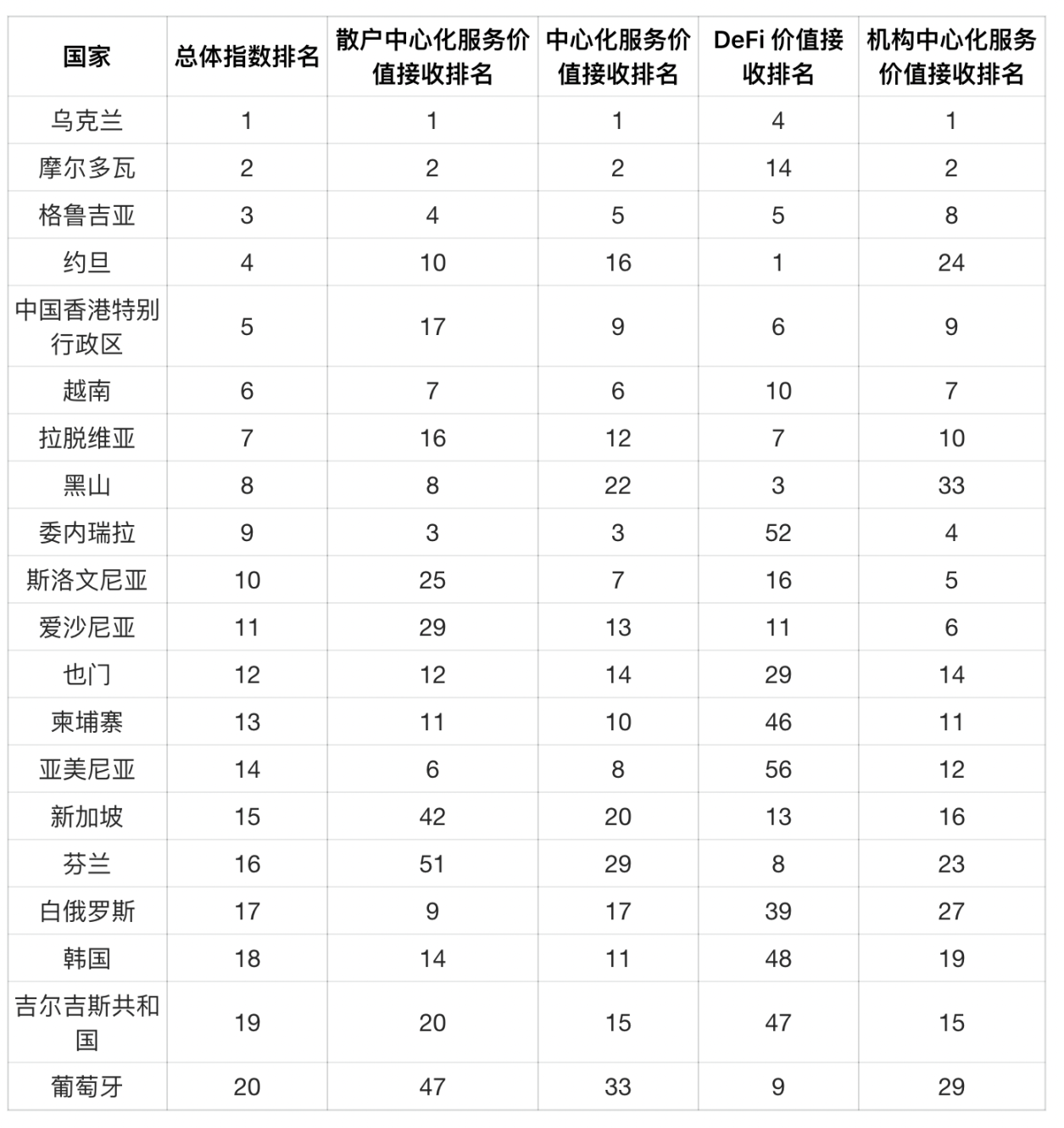
Stablecoins Surge Globally
In the past 12 months, the regulatory landscape for stablecoins has undergone significant changes. While the U.S. "Genius Act" has yet to take effect, its passage has sparked strong institutional interest, and in the EU, the "Markets in Crypto-Assets Regulation" (MiCA) has paved the way for the launch of licensed euro-pegged stablecoins like EURC.
However, when we look at on-chain data, stablecoin trading volume is still dominated by USDT and USDC, which have consistently outpaced other stablecoins in scale. From June 2024 to June 2025, USDT processed over $1 trillion in monthly trading volume, peaking at $1.14 trillion in January 2025. Meanwhile, USDC's monthly trading volume ranged from $1.24 trillion to $3.29 trillion, with particularly high activity in October 2024. These trading volumes underscore the continued core position of Tether and USDC in cryptocurrency market infrastructure, especially in cross-border payments and institutional activity.
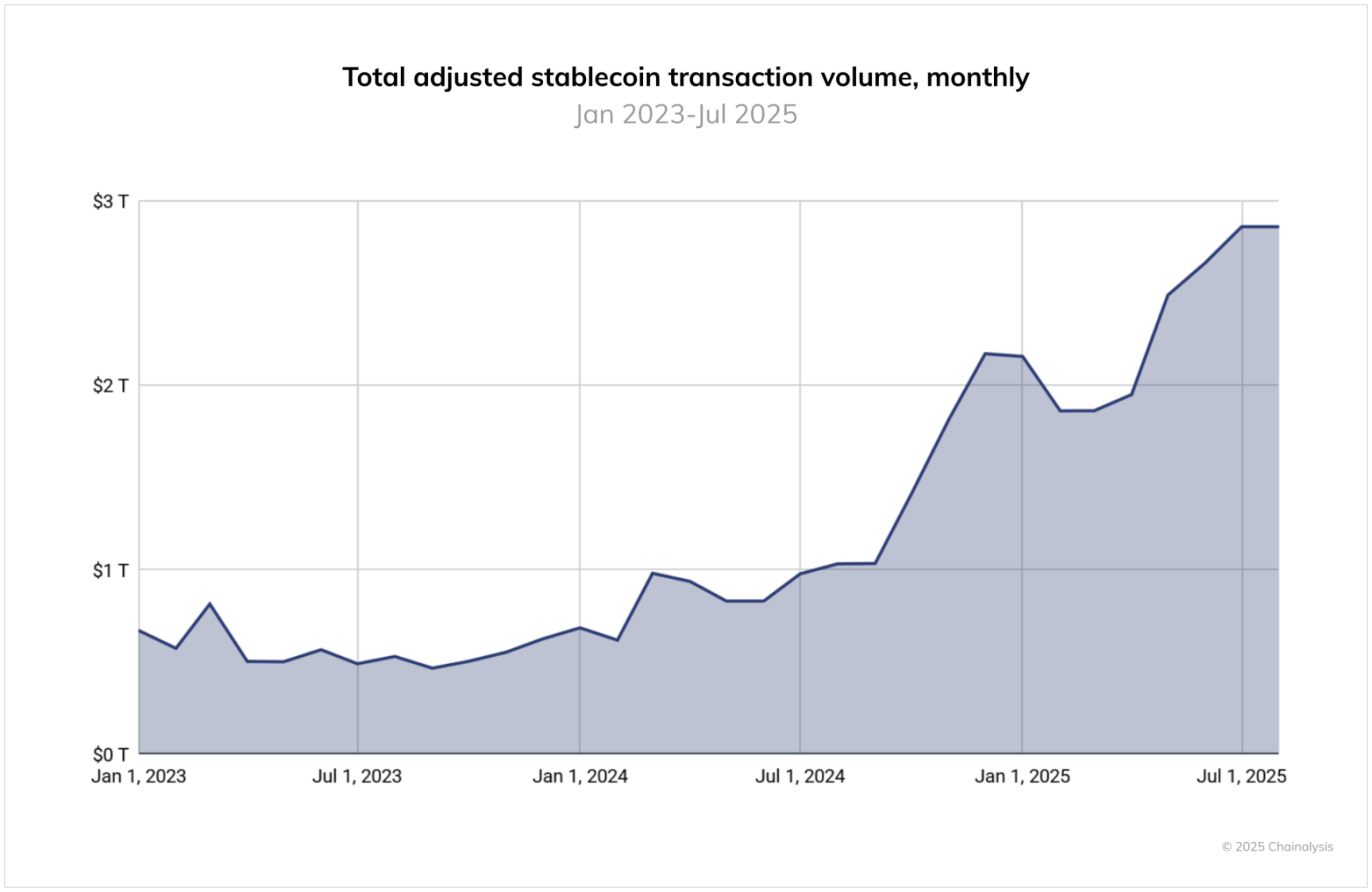
However, observing growth trends reveals different dynamics. While Tether and USDC have experienced some fluctuations, smaller stablecoins like EURC, PYUSD, and DAI have seen rapid growth. For example, EURC averaged nearly 89% month-on-month growth, with monthly trading volume increasing from about $47 million in June 2024 to over $7.5 billion in June 2025. PYUSD also showed sustained accelerated growth, increasing from about $783 million to $3.95 billion during the same period.
These changes align with increased institutional activity surrounding stablecoins. Stripe, Mastercard, and Visa have launched products allowing users to spend stablecoins through traditional channels, while platforms like MetaMask, Kraken, and Crypto.com have introduced stablecoin payment features linked to debit cards. On the merchant side, collaborations among companies like Circle, Paxos, and Nuvei aim to simplify stablecoin settlement. Meanwhile, traditional financial institutions like Citibank and Bank of America have announced plans to explore expanding their product offerings, even hinting at the potential launch of their own stablecoins.

Regionally, these differences may signal a change in how stablecoins are used. The growth of USDC appears closely tied to institutional channels and regulated corridors in the U.S., while the rise of EURC indicates a growing interest in euro-denominated digital assets, potentially driven by MiCA-compliant platforms and the adoption of European fintech. The growth of PYUSD may suggest a broader demand for other highly regulated stablecoins in retail and payment environments. These developments indicate that the landscape of stablecoins is diversifying but also expanding, with local use cases increasingly influencing global trading volumes.
Fiat Entry: Bitcoin Remains the Primary Gateway
To assess fiat entry behavior, we examined purchases made on centralized exchanges from July 2024 to June 2025, where users trade fiat currency pairs to buy cryptocurrency. Each transaction is categorized based on the asset purchased, allowing us to evaluate which types of tokens serve as the primary gateways into cryptocurrency.
Bitcoin leads by a significant margin, accounting for over $4.6 trillion in fiat inflows during this period. This is more than double the inflow of the second-ranked Layer 1 tokens (excluding BTC and ETH), which saw inflows of about $3.8 trillion. Stablecoins rank third with $1.3 trillion, followed by altcoins at approximately $540 billion. Other categories, including low liquidity tokens, meme coins, and DeFi, each saw fiat inflows of less than $300 billion.
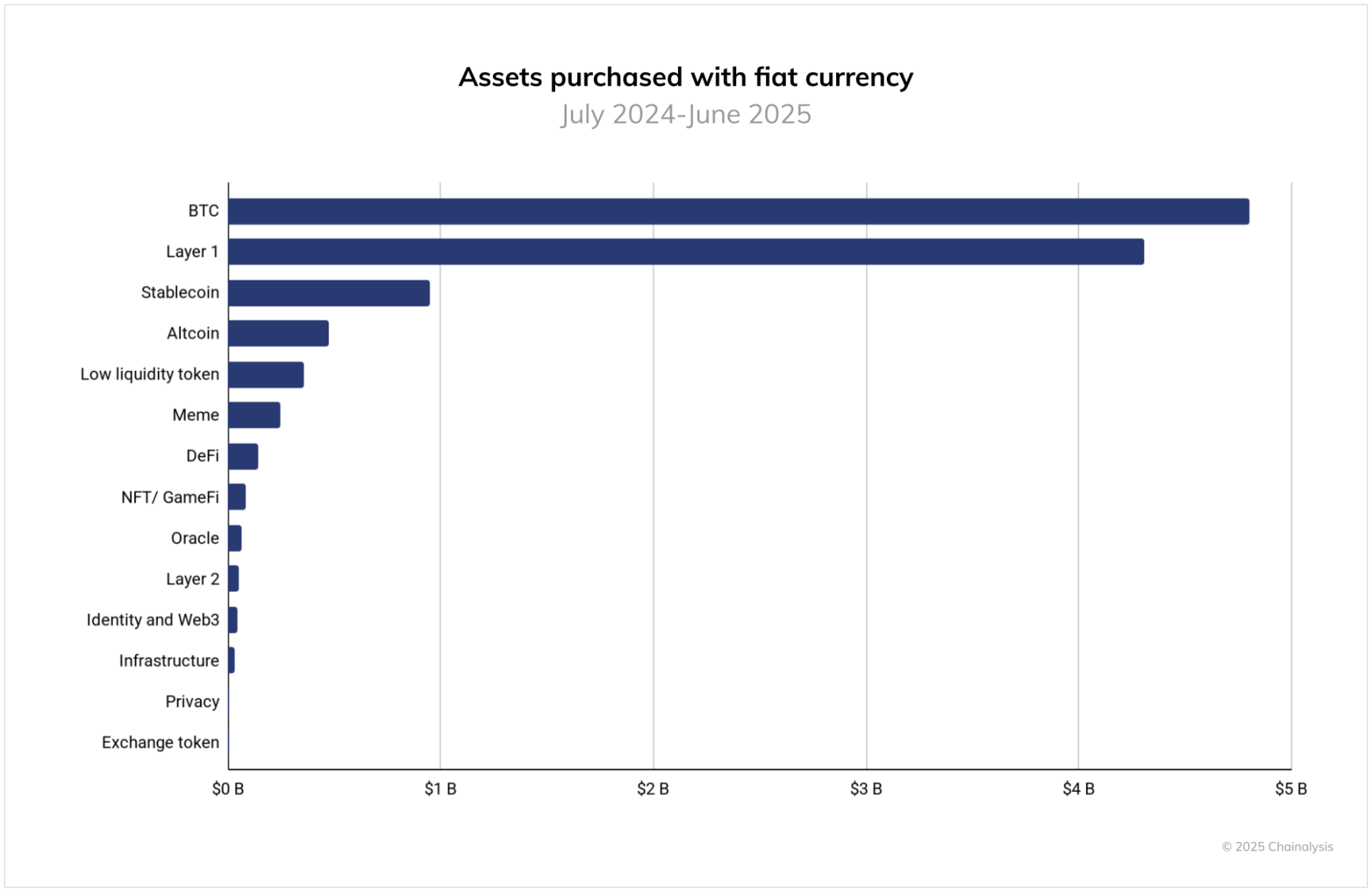
Geographically, the U.S. remains the largest fiat entry point, with total trading volume exceeding $4.2 trillion, more than four times that of the second-largest country. South Korea follows with over $1 trillion in trading volume, while the EU's trading volume is slightly below $500 billion. Bitcoin's dominance (the percentage of total fiat purchases allocated to BTC) is particularly high in the UK and EU, at approximately 47% and 45%, respectively. In contrast, South Korea's entry is more diversified, with a lower share of trading volume attributed to Bitcoin.
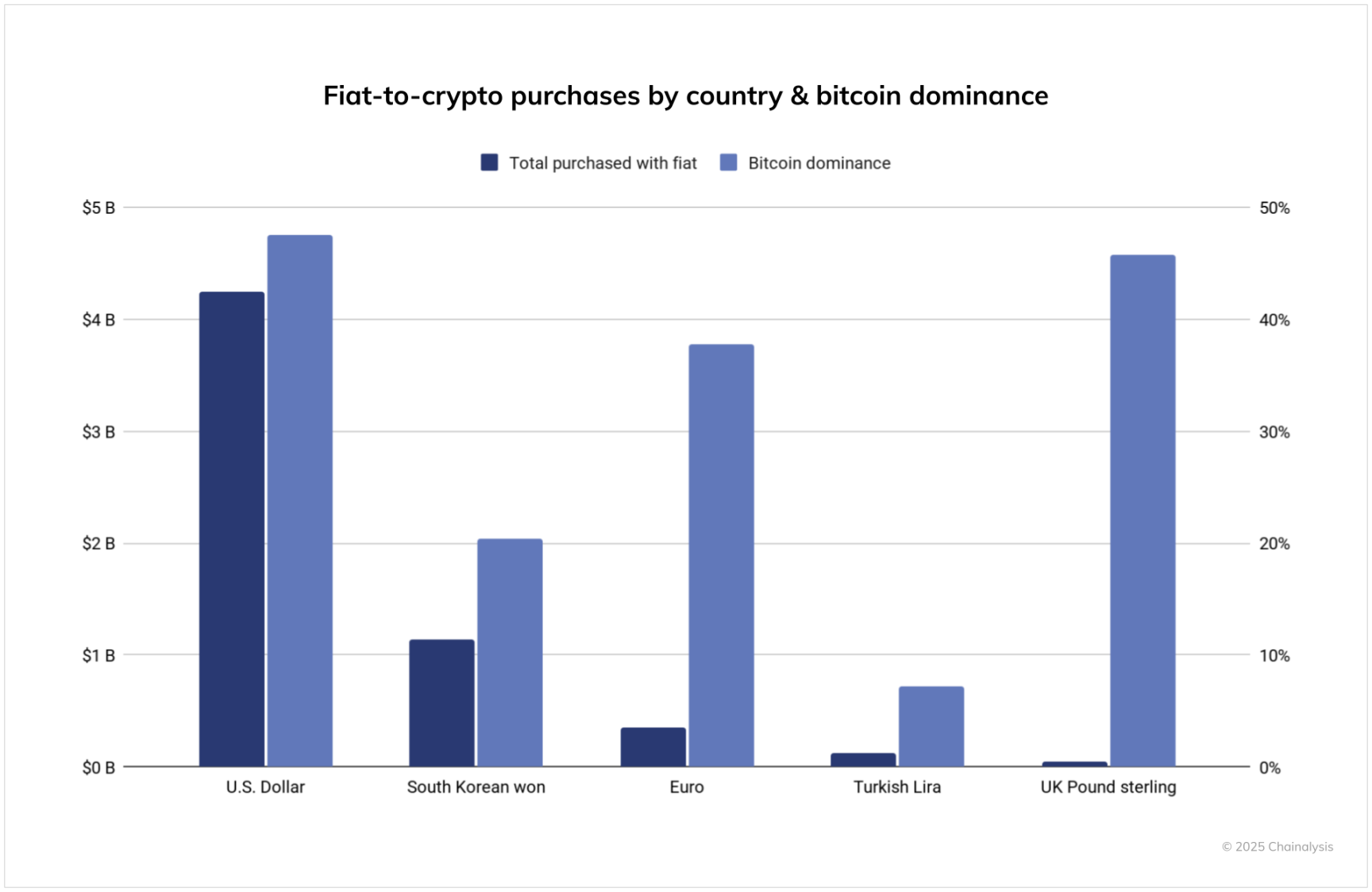
It is important to note that this analysis only includes fiat entry activity on tracked centralized exchanges and does not cover activities through over-the-counter trading, informal markets like Hawala, or cash-based cryptocurrency stores.
Adoption Spans Nearly All Income Tiers
If we break down the global adoption index into quarterly time series and segment it by the World Bank's income tiers, a clear picture emerges: high-income, upper-middle-income, and lower-middle-income tiers all reached peaks in this report. This synchronicity indicates that the current wave of cryptocurrency adoption is broad rather than isolated, benefiting both mature markets with clearer rules and institutional frameworks and emerging markets with ongoing accelerated adoption for remittances, access to dollars through stablecoins, and mobile-first finance. In other words, cryptocurrency adoption is truly global.
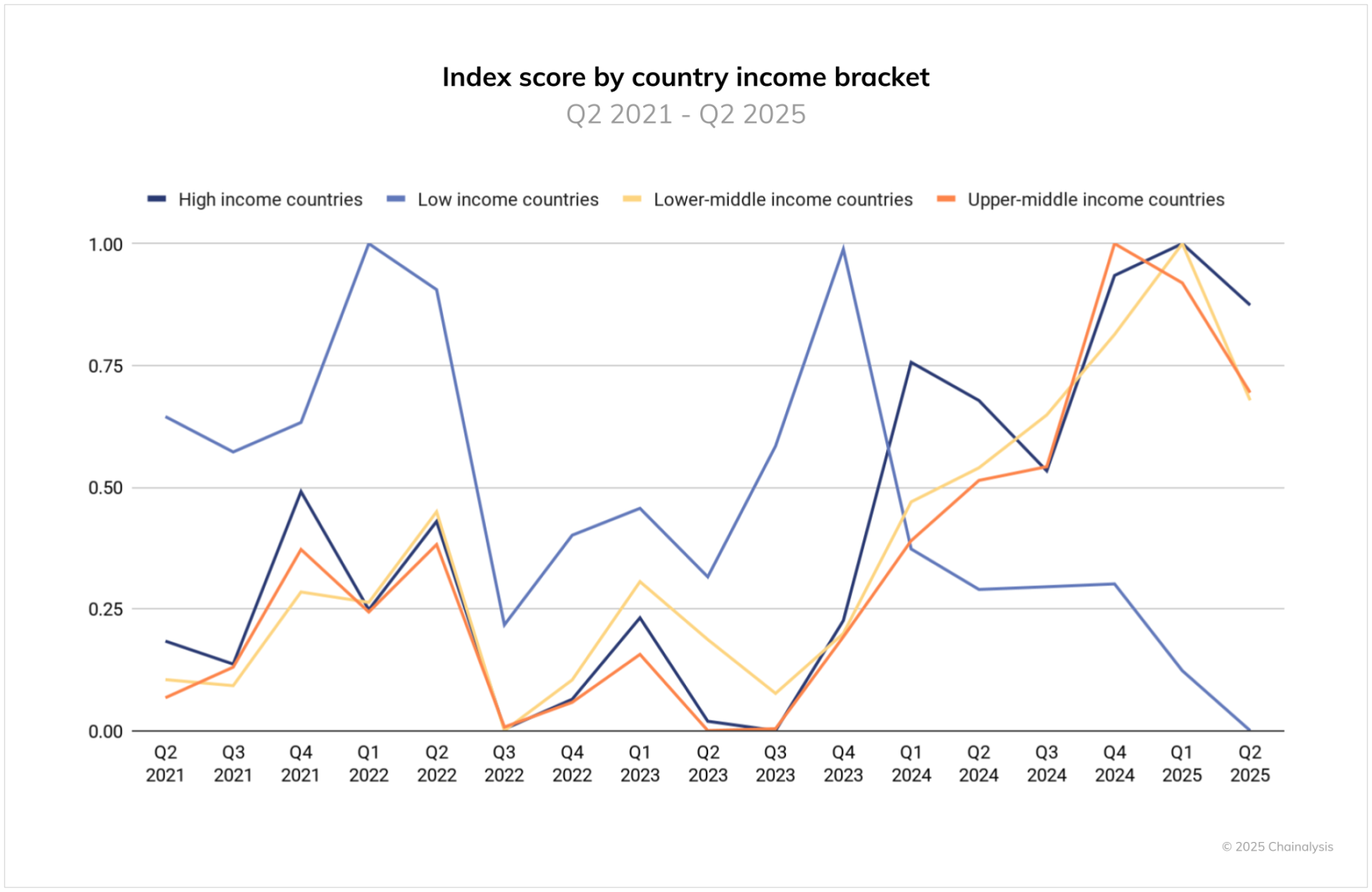
There is an important caveat within the low-income country group. This group includes several countries where you would not typically expect sustained high levels of cryptocurrency usage, and this composition leads to greater volatility: a brief surge followed by a subsequent decline. This is driven by factors such as policy shocks, liquidity constraints, and disruptions related to conflict. For example, Afghanistan is a low-income country where Chainalysis found that the country temporarily lost all cryptocurrency activity following the U.S. withdrawal in 2021. The global peak signals are real, but the trends in low-income countries are more fragile and unstable; sustainable growth there will depend on improved entry points, regulatory transparency, and basic financial and digital infrastructure.
免责声明:本文章仅代表作者个人观点,不代表本平台的立场和观点。本文章仅供信息分享,不构成对任何人的任何投资建议。用户与作者之间的任何争议,与本平台无关。如网页中刊载的文章或图片涉及侵权,请提供相关的权利证明和身份证明发送邮件到support@aicoin.com,本平台相关工作人员将会进行核查。




